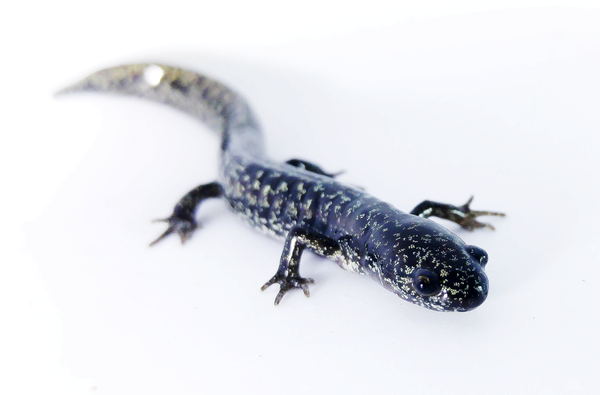On a recent expedition into southeastern Georgia’s backwoods, after 137 hours of searching through blackwater ponds with nets, amphibian specialist Mark Mandica came away with two flatwoods salamander larvae, a federally endangered species. Although only a meager find, the larval pair was “unfortunately considered a huge success,” the executive director of the Amphibian Foundation laments.
Flatwoods are extremely rare: Since 2000 populations have declined by 90 percent throughout their range in the U.S. Southeast. Habitat loss is one key cause. Only 3 percent of their natural territory, longleaf pines, remains. Another is forest fire prevention: Flatwoods hibernate underground during the summer fire season but humans have been setting controlled burns in the winter, roasting the poor creatures. To combat their decline, Mandica plans to rear the larvae and ultimately breed flatwoods in captivity, the first attempt with this species, but it is an act of desperation. “It’s their only shot,” Mandica says.
Yet flatwoods are only of the most immediately threatened salamanders. Beyond U.S. shores, the lizardlike amphibians face unprecedented existential threats. Over half of salamander species listed by the International Union for Conservation of Nature—282 out of 560—fall under a Threatened category. Increased land development, poor water quality and disease are leading drivers of their habitat loss. And although American salamanders, the most diverse population in the world, have been faring well in comparison, scientists are now bracing for an extraordinary threat: an Asian chytrid fungus called Batrachochytrium salamandrivorans, or Bsal. With a near 100 percent fatality rate for certain species, the water-borne fungus is akin to salamander kryptonite.
On supporting science journalism
If you're enjoying this article, consider supporting our award-winning journalism by subscribing. By purchasing a subscription you are helping to ensure the future of impactful stories about the discoveries and ideas shaping our world today.
Infected animals develop skin erosions, followed by deep ulcerations and microscopic skin necrosis. Death strikes in a matter of days. Bsal, which was first documented in the Netherlands in 2014, has since spread to wild populations in Germany and Belgium and has also been detected in the British pet trade. Certain species are more susceptible than others. Fire salamanders, one of the most common species in Europe, for example, have declined by 96 percent in the Netherlands since 2010. Spotted salamanders, in contrast, exhibit no mortality from Bsal in lab tests. (Flatwoods have not been tested, Mandica says, but are assumed to be susceptible.) Whereas the fungus has not yet appeared in the U.S., observers are bracing for impact. “Watch Out for Bsal,” reads the title of one recent federal fact sheet. “It’s Not Just Another Government Acronym!” “The scariest part about it is that, from what we know so far, the species that are potentially the most vulnerable are some of our most widely distributed species,” explains Priya Nanjappa, an ecologist with the Association of Fish & Wildlife Agencies and head of the response division of the Bsal task force, a quasi-governmental group formed in June 2015.
The stakes are high. If Bsal crosses the Atlantic, around 50 out of the nearly 200 salamander species in the U.S. are at risk of “crashing,” Nanjappa says. One potential victim is the eastern newt, which is shown in labs to be highly susceptible to the fungus. Ranging from New York State to Texas, it is one of America’s most common salamanders. Such a sudden and rapid depletion of salamander species, especially ones with dense populations such as the eastern newt, could have “cascading effects” in affected ecosystems, says Michael Lannoo, a herpetologist at Indiana University and expert on amphibian declines. Salamanders are critical in nutrient cycling, for example.
The eastern newt is also the focus of an ongoing multi-university project to engineer a resistance to Bsal using beneficial bacteria native to the salamanders’ skin. The idea is to reproduce the naturally occurring bacterial isolates and then administer them directly onto specimens’ skin, a solution which project lead Doug Woodhams at the University of Massachusetts, Boston calls “proactive conservation measures.” Isolates might also be planted in soil to “colonize” salamanders as they walk through it, Woodhams says. Field tests will begin in the fall.
It is the kind of proactive action that was impossible to implement with Bsal’s predecessor. Batrachochytrium dendrobatidis, or Bd, a fungal pathogen first documented in San Diego in the late 1990s, was able to spread and kill amphibians, mostly frogs, “before anybody knew it existed,” says Joe Mendelson, an herpetologist at Zoo Atlanta. In Central America and Australia Bd extirpated a handful of species from the wild. But although Bsal, a close relative of Bd, is somewhat familiar, it is even more formidable: Unlike Bd, which is thought to have been present in the Americasin pockets before the last outbreak, Bsal is completely new; native species possess very little resistance. “Once this thing gets loose in the wild we will not be able to stop it,” Mendelson says. “We have an opportunity here to do what we couldn’t do with Bd, which is to keep it from getting here.”
To that end, the U.S. Fish and Wildlife Service announced a ban on interstate travel and importation of 201 salamander species in January 2016, which is still in place. Many like Lannoo, however, feel Bsal’s arrival is inevitable. The only hope to avoid catastrophic loss when it gets here, he says, is vigilant preparation. “Every action movie has that point 10 minutes before the end of the movie where there’s a countdown and somebody has to do something in order to prevent all the missiles from being fired,” he says. “We’re sort of at that point.”
